How many stunt performers work on a movie?
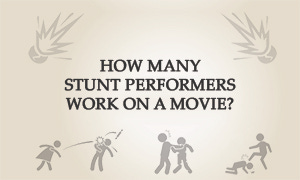
The film industry is full of under-appreciated people whose work doesn't get the recognition it deserves. Visual effects teams make movie stars look younger, body doubles make them look sexier and writers make them seem normal and likeable.
But only one set of such heroes put their lives on the line in the course of their day jobs - stunt performers.
There has been a long-running campaign to get stunt performers recognised by the Oscars. Despite campaigning for over 25 years and gaining over 50,000 signatures, stunt performers haven't yet managed to convince the Academy to add a stunt category.
Not only is their work under-recognised, it's also often extremely dangerous. The past two months have brought us two tragic stunt accidents. Stuntman John Bernecker died from a fall onto concrete while performing for The Walking Dead and just last week stuntwoman Joi Harris was killed in a motorcycle accident on the set of Deadpool 2.
To get a sense of the profession's impact on the industry, let's take a look at how many stunt people there are, and how many are involved with typical movies. To study this, I built a dataset of all live-action feature films which were released in US cinemas 2000-16 (7,303 movies in total). I then used public sources to look at the credited stunt professionals.
Using this data, there are three ways of measuring the number of stunt professionals in modern movies:
Credit - By the number of stunt credits each year.
People - By the number of people who worked as a stunt professional on a movie.
Ubiquity - The percentage of films with at least one stunt professional in the crew.
Let's take a look at each in turn.
How many stunt professionals work each year?
First up, the number of credits. Last year, there were 5,903 stunt credits on movies released in US cinemas, 75% more than in 2000.
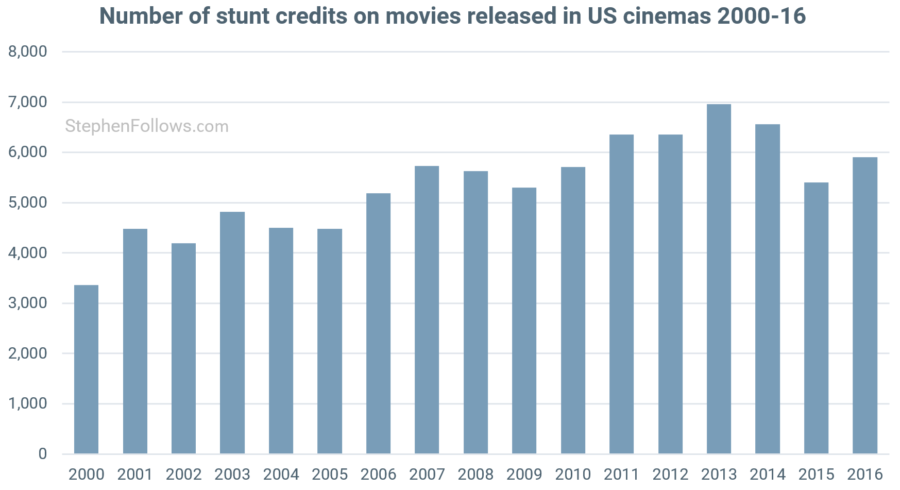
How many people work as a stunt professional?
Over the seventeen years I studied, 17,772 people received at least one credit as a stunt professional. Of those, 56% only received one stunt credit. Only 8.9% received more than seventeen stunt credits, the equivalent of one per year.
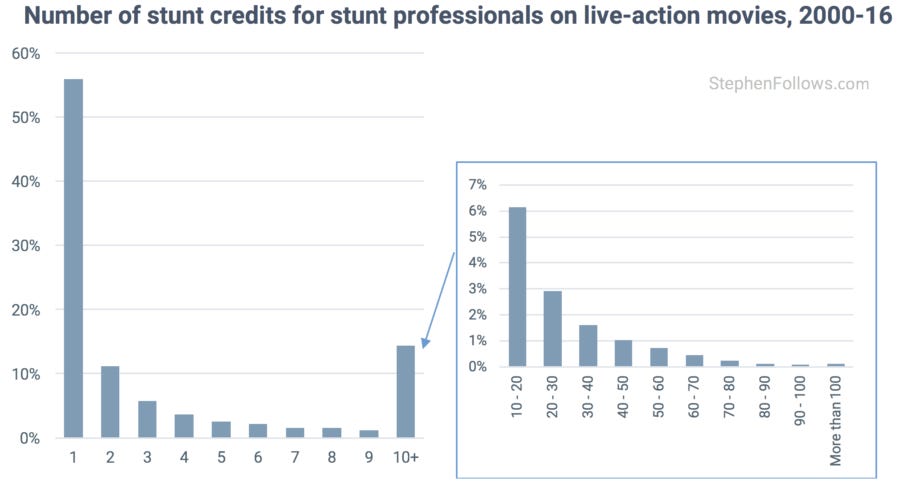
How ubiquitous are stunt professionals on modern movies?
Stunt professionals don't just work on the loud, crashy, smashy movies. 74% of movies released between 2000 and 2016 had at least one stunt professional listed. In some cases, this will be a stunt performer acting on-screen, while other times it could be stunt co-coordinator who is helping the actors perform physical feats, such as struggles, fights or falling over.
The chart on the left shows the percentage of films with at least one stunt professional credited, while the chart on the right shows the percentage of films with at least ten stunt professionals. Action and Adventure films are the most likely to credit stunt professionals, with Music-based films being the least.
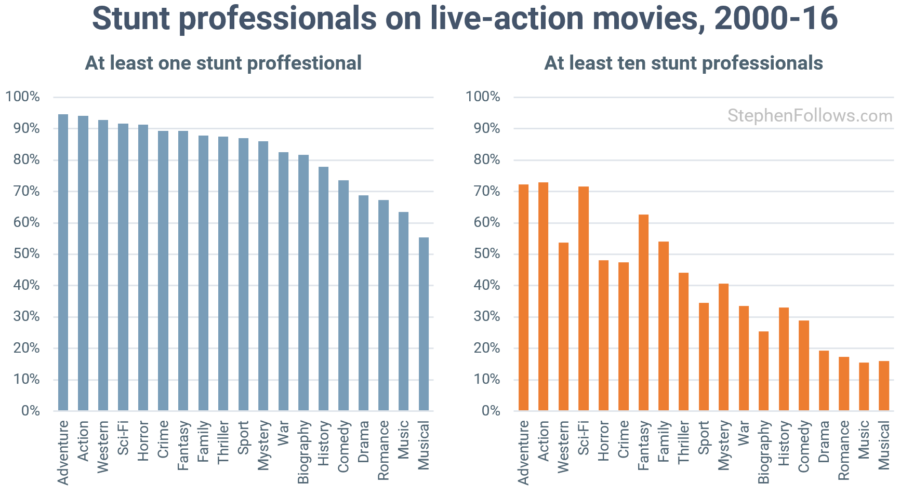
The average action and adventure movie has almost 46 stunt professionals credited.
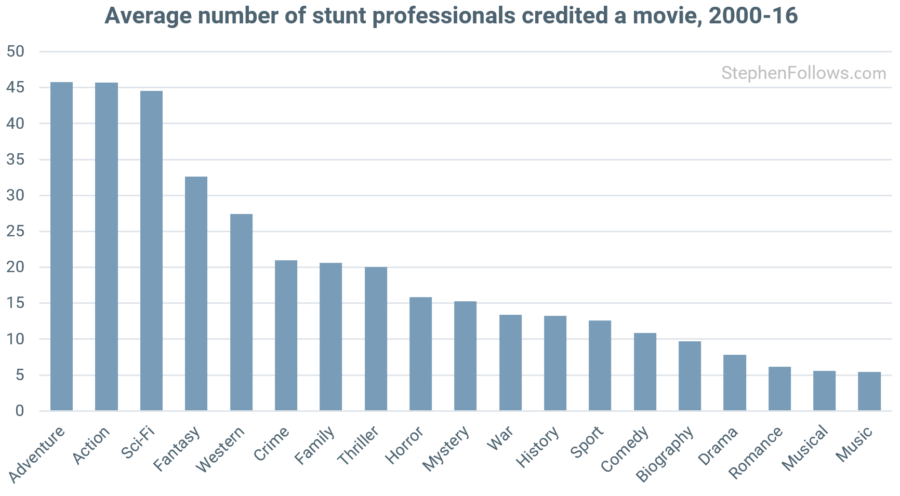
Over the period I studied, The Dark Knight Rises hired the largest number of stunt personnel, most likely due to its large street battles and Christopher Nolan's penchant for using real elements over visual effects whenever possible. The top stunt-heavy movies include:
267 stunt professionals - The Dark Knight Rises
246 - Furious 7
243 - Avengers: Age of Ultron
232 - The Green Hornet
216 - Transformers: Dark of the Moon
203 - Captain America: Civil War
201 - The Hunger Games: Mockingjay - Part 2
194 - Suicide Squad
191 - The Bourne Ultimatum
190 - RoboCop
Stunt professionals make up an average of 8.4% of the crew on Westerns, 8.3% on Action movies and 7.5% on Crime movies.
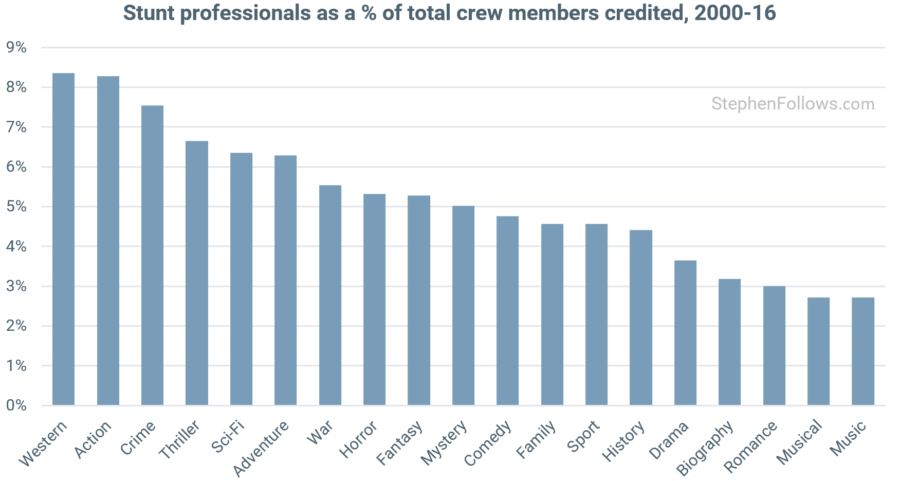
Bonus facts: The gender and seniority of stunt professionals
I classified the stunt credits by gender and also into three levels of seniority:
Senior - Including coordinators, team leaders, choreographers, action directors and supervisors.
Performer - covering all aspects of on-screen stunt work
Support and Other - Including rigging, stunt pre-viz, training, stunt stand-ins, interpreters, stunt liaisons and stunt technicians.
The world of stunt performers is heavily male-dominated, with 86% of stunt credits going to men.

Some stunt roles sound harder than others. For example, it may be fair to assume that the people who performed as stunt werewolf, stunt hooker, stunt blind driver and bear stunts had a harder day at work than those playing stunt princess, stunt mother, stunt basketball player and stunt partier.
Notes
Here are a few notes about today's research:
My dataset of films covers all live-action feature films which grossed at least one dollar in US cinemas between 1st January 2000 and 31st December 2016. This was 7,303 movies in total.
This research is looking at stunt credits, meaning that if someone worked on two films, they would appear twice.
It not possible to measure the amount of work someone put into a movie. Therefore, someone who worked throughout the shoot will show up the same as someone who worked just for one day. Sadly, looking at movie credits doesn't give us a way to measure input or value to the production.
A very small number of action and adventure films in the dataset do not credit any stunt professionals. This is due to a mix of film-specific reasons (one such example is the live-action puppet film Team America: World Police) and incomplete data online (such as Train to Busan, which on IMDb only credits 22 crew members across all departments).
Due to the way I gathered the data, it would be very hard to work out the gender split by level of seniority. At this stage, I have no reason to suspect that the gender split differs by level of seniority.
Epilogue
I have wanted to cover the world of stunt performers for a while but haven't done so yet. My eventual aim is to do a survey of stunt professionals, as I have with directors, cinema staff, employers, assistant directors, film students and film festival directors. However, this normally involves working with an organisation (or some motivated volunteers). So, for today, I have stuck to the big picture.
It's getting harder and harder to know which elements of a modern movie are for real and which are created digitally. Normally, the best work is a blend of real elements (expositions, stunts, etc) and digital elements (compositing, computer-generated effects, etc). The video below highlights the incredible stunt work that went into creating Mad Max: Fury Road by removing the visual effects elements:
Pedantic note: I can't help but point out that the title of this YouTube video is wrong. "Special effects" refer to physical elements created for real, such as fire, water, wind, stunts, etc, whereas "visual effects" normally refers to computer-based work. Therefore this video should be titled "Mad Max: Fury Road without visual effects is still freaking awesome".


